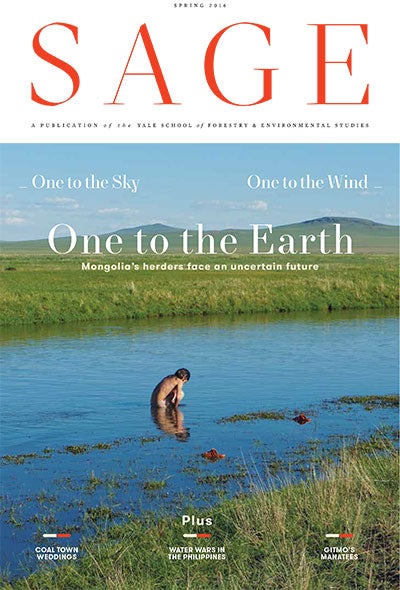Note: Yale School of the Environment (YSE) was formerly known as the Yale School of Forestry & Environmental Studies (F&ES). News articles and events posted prior to July 1, 2020 refer to the School's name at that time.
Sage, a student-run publication of the Yale School of Forestry & Environmental Studies, will release its 2016 print issue at a special event Thursday, April 21 from 6 to 9 p.m. in Bowers Auditorium. The issue features stories, all written by F&ES contributors, about place.

In an interview, Editor in Chief Will Murtha ’16 M.E.M.talked about the new print issue and how students can become involved with Sage. The issue will be available in buildings across campus.
Will Murtha: The 2016 print issue of Sage explores our connections to place in a rapidly changing world. We asked our contributors to reflect on a simple, yet profound question: What creates meaning in a place? In answer, we received a thrilling range of responses. For some, the response was deeply personal. Nicole Wooten wrote a beautiful piece on finding wilderness in her backyard creek in North Carolina. Mikael Cejtin took the question to a much larger scale and investigated how mining interests are altering Mongolian herders’ relationship to the land. The issue also features some amazing original artwork and even an interview of a biologist studying manatees in Guantanamo Bay.
Murtha: With this issue, we wanted to highlight the abundance of writing and creative talent at F&ES and, more broadly, at Yale. I think we succeeded. From the F&ES community, we feature the work of first and second-year students (and one third year), as well as a recent graduate, Maha Qasim (’15 M.E.M.). I am continually amazed at the diversity of experiences lived by our student body.
Murtha:Sagelaunched a very successful live storytelling event, dubbed "Sage Stories," in the fall. Max Webster took top prize for a riveting tale of juvenile Sasquatch behavior in Alaska. Expect to see more events like it in the future. Our website, sagemagazine.org, continues to feature a mix of content both topical and timeless. Sage also hosted a workshop with Ben Goldfarb [former Sage editor and current correspondent for High Country News] for students interested in getting published and pursuing careers as environmental writers. We're also very excited to co-sponsor the upcoming Science & Storytelling Symposium.
Murtha:It was challenging but extremely rewarding. As a relative novice to the world of environmental journalism, I relied on the support of my staff, former Sage editors, and Sage's faculty adviser, Fred Strebeigh. The 2016 print issue is a product of their insight and hard work.
Murtha:Sageis always looking for new talent. We’re a student-run publication, which gives us a certain degree of freedom and latitude not afforded other publications. Whether you’re interested in writing long-form narratives, conducting interviews with luminaries in your field, writing poetry, or recording podcasts, Sage is a great place to explore those interests. Students can drop by our weekly staff meetings, held Wednesdays at 5:30 in Sage 41C, or get in touch with me or Max Webster, my successor as Editor in Chief.
The 2016 issue has a recognizable look, but what can people expect to find inside?
Will Murtha: The 2016 print issue of Sage explores our connections to place in a rapidly changing world. We asked our contributors to reflect on a simple, yet profound question: What creates meaning in a place? In answer, we received a thrilling range of responses. For some, the response was deeply personal. Nicole Wooten wrote a beautiful piece on finding wilderness in her backyard creek in North Carolina. Mikael Cejtin took the question to a much larger scale and investigated how mining interests are altering Mongolian herders’ relationship to the land. The issue also features some amazing original artwork and even an interview of a biologist studying manatees in Guantanamo Bay.
Talk about the contributors. Where did you get submissions for the magazine?
Murtha: With this issue, we wanted to highlight the abundance of writing and creative talent at F&ES and, more broadly, at Yale. I think we succeeded. From the F&ES community, we feature the work of first and second-year students (and one third year), as well as a recent graduate, Maha Qasim (’15 M.E.M.). I am continually amazed at the diversity of experiences lived by our student body.
Besides the print issue, what else has Sage been up to this year?
Murtha:Sagelaunched a very successful live storytelling event, dubbed "Sage Stories," in the fall. Max Webster took top prize for a riveting tale of juvenile Sasquatch behavior in Alaska. Expect to see more events like it in the future. Our website, sagemagazine.org, continues to feature a mix of content both topical and timeless. Sage also hosted a workshop with Ben Goldfarb [former Sage editor and current correspondent for High Country News] for students interested in getting published and pursuing careers as environmental writers. We're also very excited to co-sponsor the upcoming Science & Storytelling Symposium.
How did you balance your editorship with your coursework at F&ES?
Murtha:It was challenging but extremely rewarding. As a relative novice to the world of environmental journalism, I relied on the support of my staff, former Sage editors, and Sage's faculty adviser, Fred Strebeigh. The 2016 print issue is a product of their insight and hard work.
How can someone get involved with Sage? Why should someone get involved with Sage?
Murtha:Sageis always looking for new talent. We’re a student-run publication, which gives us a certain degree of freedom and latitude not afforded other publications. Whether you’re interested in writing long-form narratives, conducting interviews with luminaries in your field, writing poetry, or recording podcasts, Sage is a great place to explore those interests. Students can drop by our weekly staff meetings, held Wednesdays at 5:30 in Sage 41C, or get in touch with me or Max Webster, my successor as Editor in Chief.
– Timothy Brown timothy.brown@yale.edu 203 436-9503
Published
April 21, 2016